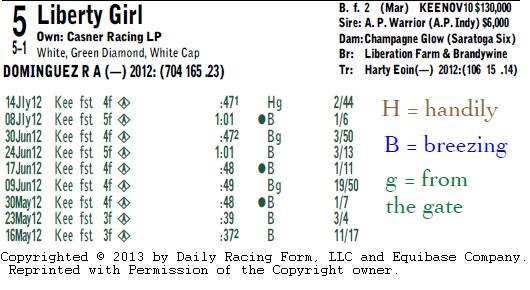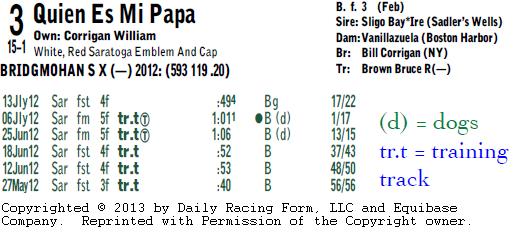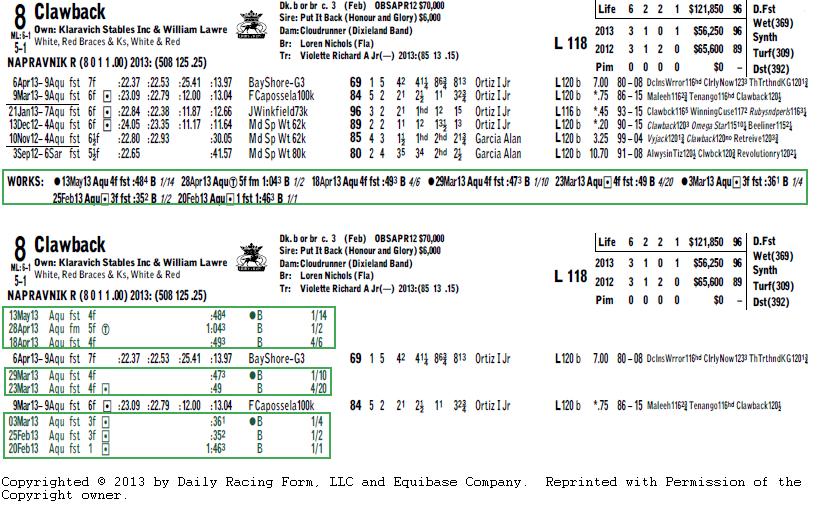Workouts – A Measure of Racing Form
Workouts are like a practice for any other athlete. Most horses in training get daily exercise, but not all exercise is considered an official workout. Official means they were timed by a track clocker, and will be published in all records of a horses past performances. Standard information presented for the workout are Date, Track, Distance, Surface, Time, Qualification, and Ranking. Qualifications on the official workouts are used to help explain the nature of the workout. I have several examples to help explain the information.
The following example is of a 2-year old filly that made her racing debut on opening day of Saratoga last year.

Liberty Girl had workouts approximately once a week from May 16 to July 14 at Keeneland, with distances ranging from 3 to 5 furlongs on their Synthetic surface. Her latest two workouts (July 14) were timed in 47 and 1/5 seconds and 1 minute and 1 second for her 5 furlong work on July 8. All fractions of a second are shown in fifths of a second. So her work on June 30 was in 47 and 2/5 seconds.
To the right of the time is the workout qualification information, and to the far right I’ve written the description for each code found in this example. Breezing describes a workout where the horse ran essentially on her own with little or no urging from the exercise rider. Handily describes a workout where the rider urges the horse by rolling his knuckles along the horse’s neck in a pumping motion that encourages more speed.
On three races you will see a (g) to the right of the H/B code. This indicates that the workout began with the horse breaking out of the gate. This is a requirement for all young horses making their first start, to have an official workout from the starting gate. It doesn’t guarantee they’ll behave on racing day, but at least demonstrates their willingness to enter the gate.
And lastly, to the right of the qualification codes is the ranking for the horse that day at that exact distance. So, on July 14 at Keeneland, 44 horses were timed at four furlongs, and Liberty Girl had the 2nd fastest time of the day. If the workout was the fastest of the day a “bullet” mark (•) is placed in the qualification column for easy viewing.
The next example shows additional information that can appear on the workouts.

This horse had two workouts with a (d) appearing to the right of the Breezing code. Dogs are rubber cones that are positioned on the ground to keep horses away from the rail. This causes the horse to run a little farther than they would have along the rail.
Finally, to the right of the distance there are five races with a “tr.t” shown. This indicates the workout occurred on the Training Track as opposed to the main track. These tracks are usually deeper and slower and are intended to help the horse develop more stamina. Times for these workouts are generally a little slower than works over the main track.
The last example we will show is to contrast the format of the information presented here to the traditional format in the Daily Racing Form for workouts. The two examples that appear earlier in this post are shown using the DRF Formulator software; specifically using the “merged workouts” option. This differs from the format you will see in a printed copy of DRF.
Here we show the exact same horse in the two different formats. The top shows how the workouts appear at the bottom of a horse’s past performances in two rows labeled “WORKS:” This is how all workouts appear in a printed copy of the Daily Racing Form. The bottom example uses the “Merged Workouts” feature and you will see that the workouts are merged (by date) with the actual races. For the sake of brevity, I cutoff this example after the last workout; which is why only two actual races are shown. Personally this format is the way I prefer to see workouts, so I can get a clear picture of everything this horse has done chronologically.


8 comments on “Workouts – A Measure of Racing Form”